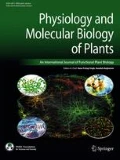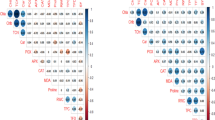Abstract
Water deficit is one of the main factors that reduce grain yield. A better understanding of the mechanisms related to this abiotic stress is a key aspect to design and act upon drought tolerance improvement in crop plants. Therefore, the major objective of this study was to investigate four common bean genotypes for drought tolerance and to establish their tolerance mechanisms. The experiment was carried out in a greenhouse, using the completely randomized design in a factorial arrangement (2 × 4), composed by 2 water conditions (well-watered and water deficit) and 4 cultivars, with six replicates per treatment. The four cultivars, two drought-sensitive (IAC Tybatã and BRS Pontal) and two drought-tolerant (IAPAR 81 and BAT 477), were evaluated for some physiological, biochemical and morphoagronomic traits. Drought promoted physiological and metabolic changes in the plants, reflecting on the morphoagronomic traits. Under water deficit, the genotype IAPAR 81 stood out from the others in terms of physiological characters, however, it presented a low efficiency concerning biochemical activities and a significant reduction in the morphoagronomic characters. The cultivar BAT 477 demonstrated to be drought-adapted presenting more efficient biochemical and morphoagronomic adaptions and the genotype BRS Pontal obtained morphoagronomic values similar to BAT 477, thus it may be classified as moderately tolerant to drought.



Similar content being viewed by others
References
Aguiar RS, Moda-Cirino V, Faria RT, Vida LHI (2008) Evaluation of promising lines of common bean (Phaseolus vulgaris L.) tolerant to water deficit. Semina: Agr Sci 29:1–13
Andrade ER, Ribeiro VN, Azevedo CVG, Chiorato AFC, Williams TCR, Carbonell SAM (2016) Biochemical indicators of drought tolerance in the common bean (Phaseolus vulgaris L.). Euphytica 210:277–289
Androcioli LG, Tomaz JP, Moda-Cirino V (2016) Physiological responses of two drought tolerant common bean cultivars. Annu Rep Bean Improv Coop 59:35–36
Apel K, Hirt H (2004) Reactive oxygen species: metabolism, oxidative stress and signal transduction. Annu Rev Plant Biol 55:373–399
Asfaw A, Blair MW (2012) Quantitative trait loci for rooting pattern traits of common beans grown under drought stress versus non-stress conditions. Mol Breed 30:681–695
Ashraf M, Foolad MR (2007) Roles of glycine betaine and proline in improving plant abiotic stress resistance. Environ Exp Bot 59:206–216
Barbin D (2013) Planejamento e análise estatística de experimentos agronômicos. Mecenas, Londrina
Beebe SE, Rao IM, Cajiao C, Grajales M (2008) Selection for drought resistance in common bean also improves yield in phosphorus limited and favorable environments. Crop Sci 48:582–592
Beebe SE, Rao IM, Blair MW, Acosta-Gallegos JA (2013) Phenotyping common beans for adaptation to drought. Front in Physiol 4:1–20
Bhargava S, Sawant K (2013) Drought stress adaptation: metabolic adjustment and regulation of gene. Plant Breed 132:21–32
Blair MW, Cortés AJ, This D (2016) Identification of an ERECTA gene and its drought adaptation associations with wild and cultivates common bean. Plant Sci 242:250–259
Boyer JS (1978) Water deficits and photosynthesis. In: Kozlowski TT (ed) Water deficits and plant growth, vol 4. Academic Press, New York, pp 154–191
Briñez B, Perseguini JMKC, Rosa JS, Bassi D, Gonçalves JGR, Almeida C, Paulino JFC, Blair MW, Chioratto AF, Carbonell SAM, Valdisser PAMR, Rosana Pereira Vianello RP, Benchimol-Reis LL (2017) Mapping QTLs for drought tolerance in a SEA 5 × AND 277 common bean cross with SSRs and SNP markers. Genet Mol Biol 40:813–823
Chaves MM, Oliveira MM (2004) Mechanisms underlying plant resilience to water defecits: prospects for water-saving agriculture. J Exp Bot 8:1–20
CIAT—Annual Report (1988) International center for tropical agriculture
Choudhury FK, Rivero RM, Blumwald E, Mittler R (2016) Reactive oxygen species, abiotic stress and stress combination. Plant J. https://doi.org/10.1111/tpj.13299
CIAT (1983) In: Fernàndez F, Gepts P, López M (eds) Etapas de desarollo de la planta de frijol común. CIAT, Cali
EMBRAPA—Agência EMBRAPA de Informação Tecnológica (2006) Empresa Brasileira de Pesquisa Agropecuária (EMBRAPA). <http://www.agencia.cnptia.embrapa.br>. Accessed 14 April 2018
Gill SS, Tuteja N (2010) Reactive oxygen species and antioxidante machinery in abiotic stress tolerance in crop plants. Plant Physiol Biochem 48:909–930
Instituto Agronômico de Campinas (IAC)—Technical Report (2001). <http://www.iac.sp.gov.br>. Accessed 14 April 2018
Instituto Agronômico do Paraná (IAPAR) (1997). <www.iapar.br>. Accessed 14 April 2018
Kavi-Kishor PB, Sangam S, Amrutha RN, Sri Laxmi P, Naidu KR, Rao KRSS, Rao S, Reddy KJ, Theriappan P, Sreenivasulu N (2005) Regulation of proline biosynthesis, degradation, uptake and transport in higher plants: its implications in plant growth and abiotic stress tolerance. Curr Sci 88:424–438
Moda-Cirino V, Oliari L, Lollato MA, Fonseca Júnior NS (2001) IAPAR 81—Common bean. Crop Breed Appl Biotechnol 1:203–204
Moda-Cirino V, Gerage AC, Riede CR, Sera GH, Takahashi M, Abbud NS, Nazareno NRX, Araújo PM, Auler PM, Yamaoka RS, Sera T, Almeida WP (2012) Plant breeding at Instituto Agronômico do Paraná—IAPAR. Crop Breed Appl Biotechnol S2:25–30
Moller IM, Jensen PE, Hansson A (2007) Oxidative modifications to cellular components in plants. Annu Rev Plant Biol 58:459–481
Mukeshimana G, Butare L, Cregan PB, Blair MW, Kelly JD (2014) Quantitative trait loci associated with drought tolerance in common bean. Crop Sci 54:923–938
Paranzini JPD (2007) Evaluation of bean cultivars reaction to the water deficit, State University of Lodrina
Petry N, Boy E, Wirth JP, Hurrell RF (2015) Review: the Potential of the Common Bean (Phaseolus vulgaris) as a vehicle for iron biofortification. Nutrients 7:1144–1173
Ramirez-Vallejo P, Kelly JD (1998) Traits related to drought resistance in common bean. Euphytica 99:127–136
Rosales MA, Ocampo E, Rodríguez-Valentín R, Olvera-Carrillo Y, Acosta-Gallegos J, Covarrubias AA (2012) Physiological analysis of common bean (Phaseolus vulgaris L.) cultivars uncovers characteristics related to terminal drought resistance. Plant Physiol Biochem 56:24–34
Sánchez-Rodríguez E, Rubio-Wilhelmi M, Cervilla LM, Blasco B, Rios JJ, Rosales MA, Romero L, Ruiz JM (2010) Genotypic differences in some physiological parameters symptomatic for oxidative stress under moderate drought in tomato plants. Plant Sci 178:30–40
Serkedjieva J (2011) Antioxidant effects of plant polyphenols: a case study of a polyphenol-rich extract from Geranium sanguineum L. In: Gupta SD (ed) Reactive oxygen species and antioxidants in higher plants, vol 13. Science Publication, Enfield, pp 275–293
Singh M, Kumar J, Singh S, Singh VP, Prasad SM (2015) Roles of osmoprotectants in improving salinity and drought tolerance in plants: a review. Rev Environ Sci Bio 14:407–426
Sommano S (2015) Physiological and biochemical changes during heat stress induced browning of detached Backhousia myrtifolia (cinnamon Myrtle) tissues. Trop Plant Biol 8:31–39
Taiz L, Zeiger E (2009) Plant physiology, 4th edn. Sinauer Associates, INc Publisher, Sunderland, p 848p
Terán H, Singh SP (2002) Comparison of sources and lines selected for drought resistance in common bean. Crop Sci 42:64–70
Author information
Authors and Affiliations
Corresponding author
Rights and permissions
About this article
Cite this article
Arruda, I.M., Moda-Cirino, V., Koltun, A. et al. Physiological, biochemical and morphoagronomic characterization of drought-tolerant and drought-sensitive bean genotypes under water stress. Physiol Mol Biol Plants 24, 1059–1067 (2018). https://doi.org/10.1007/s12298-018-0555-y
Received:
Revised:
Accepted:
Published:
Issue Date:
DOI: https://doi.org/10.1007/s12298-018-0555-y




